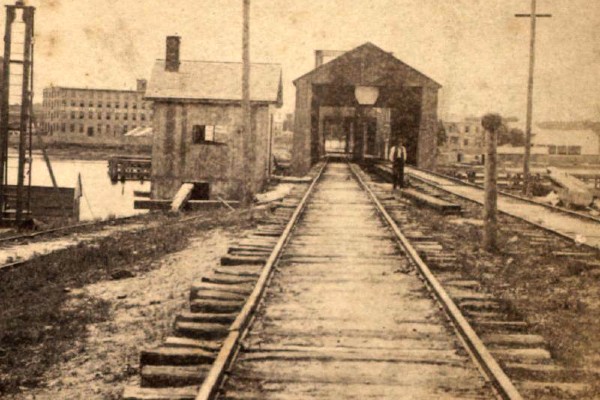 The Harlem River Lift Bridge (also known as the Park Avenue Bridge) is a vertical lift bridge carrying the Metro-North Railroad’s Hudson Line, Harlem Line, and New Haven Line in 1841.
The Harlem River Lift Bridge (also known as the Park Avenue Bridge) is a vertical lift bridge carrying the Metro-North Railroad’s Hudson Line, Harlem Line, and New Haven Line in 1841.
These lines ran across the Harlem River between the boroughs of Manhattan and the Bronx in New York City. The average weekday ridership on the lines is 265,000.
History
First bridge
The first bridge on this site was constructed by the New York and Harlem Railroad in 1841. It was composed of four 90-foot (27 m)-long box truss spans, three of which were fixed iron spans, while the remaining span was a wooden swing span.
In the closed position, the bridge had a clearance of only seven feet above mean high water. Masonry piers supported the four box-truss spans.
In 1867, the wooden drawbridge was replaced with an iron one that gave a clearance of 50 feet. By the 1880s, the bridge was crossed by more than 200 trains a day.
Second and third bridges
The 1867 bridge was soon made obsolete by heavy traffic and dredging of the Harlem River Ship Canal. In 1888, the United States Department of War began work on the Harlem River to allow for unrestricted shipping activity between the Hudson River and the East River and through the new Harlem River Ship Canal at 225th Street.
The New York Central was opposed to the project as the increase in river traffic would interfere with its rail line, which was only 8 feet (2.4 m) above the water.
In 1890, the New York and Northern Railway, a competitor of the New York Central which operated freight traffic to the Bronx shore which relied upon barges to ship its freight, complained to the Department of War about delays to its traffic due to the New York Central’s low bridge.
To remedy the situation, the Central could have raised the bridge to 24 feet (7.3 m) above the water to satisfy the Department of War, allowing most vessels to cross under the bridge, for $300,000 or replaced it with a tunnel to satisfy the Harlem community for $3 million.
To remedy the situation, the Central could have raised the bridge to 24 feet (7.3 m) above the water to satisfy the Department of War, allowing most vessels to cross under the bridge, for $300,000 or replaced it with a tunnel to satisfy the Harlem community for $3 million.
The railroad opted to raise the bridge, which was the only four-track drawbridge in the country at the time. Alfred P. Boller worked with the railroad to create the new four-tracked swing bridge.
However, due to political pressure, it had to raise the grade of its line north of 115th Street on a viaduct in Harlem, raising the project’s cost significantly.
In 1892, a law was passed establishing the Board of Park Avenue Improvement, and under the terms of the law, New York City was to pay for half of the project, with the remainder paid for by the New York Central.
The new bridge was to be 400 feet (120 m)-long and was built for about $500,000 by the King Bridge Company.
The new bridge was to be 17 feet (5.2 m) higher than the old bridge, as mandated by the Federal Government, making it 24 feet (7.3 m) above the water.
The Park Avenue Line’s grade had to be raised to allow it to reach the higher bridge, and as a result, a new four-track steel viaduct was built between 132nd Street and 106th Street in Harlem.
The Park Avenue Line’s grade had to be raised to allow it to reach the higher bridge, and as a result, a new four-track steel viaduct was built between 132nd Street and 106th Street in Harlem.
During the course of construction, trains were to run over a temporary wooden structure along with a temporary two-track wooden drawbridge.
The cost of the entire project was to be $2 million. At the time, construction was expected to begin on September 1, 1893. The work was divided into four sections.
The bridge’s design was underway in 1894, and in February of that year, the project was expected to be completed in December 1895.
Service continued to operate while the complex work proceeded through a procedure involving the installation of temporary wooden trestles, trusses, and the installation of columns.
On February 15, 1897, trains on the Harlem Division started running over the new drawbridge over the Harlem River and the elevated structure connecting to it.
On February 15, 1897, trains on the Harlem Division started running over the new drawbridge over the Harlem River and the elevated structure connecting to it.
The Department of War ordered that the bridge cannot be opened during peak hours, between 7 and 10 a.m. and 4 and 7 p.m.
Current bridge
Between 1954 and 1956, the New York Central Railroad built a fourth rail bridge on this site, this time a vertical-lift bridge, to replace the 1897 bridge.
The new bridge opened in 1956. The four-track bridge remains in use today and consists of two parallel double-track spans, 340 feet (100 m) long. It has 25 feet (7.6 m) of clearance when closed and 135 feet (41 m) when open.
During the 1960s, the bridge came under the ownership of several different companies, including Penn Central Railroad. Metro-North operates it, referring to it as the Harlem River Lift Bridge.
Photo credit: Source.
Become a Harlem Insider!
By submitting this form, you are consenting to receive marketing emails from: Harlem World Magazine, 2521 1/2 west 42nd street, Los Angeles, CA, 90008, https://www.harlemworldmagazine.com. You can revoke your consent to receive emails at any time by using the SafeUnsubscribe® link, found at the bottom of every email. Emails are serviced by Constant Contact








